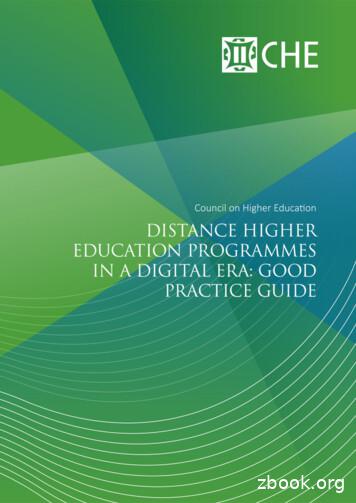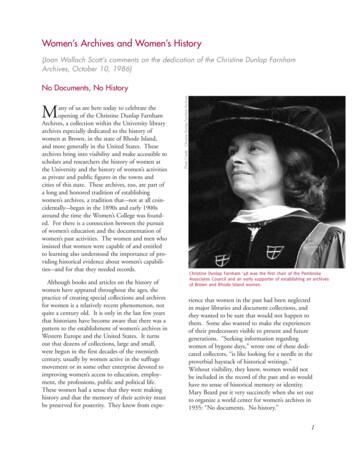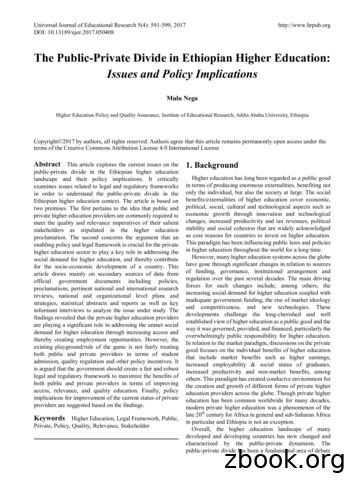Women In Higher Education In Iran
Women in Higher Education in IranStudent perceptions of career prosperity in thelabour marketEffat ZahedifarMasters of Philosophy in Comparative International Education,Institute of Educational ResearchUNIVERSITETET I OSLOSpring 2012
Women in Higher Education in IranStudent perceptions of career prosperityin the labour marketii
Forfatter2012Women in Higher Education in IranEffat Zahedifarhttp://www.duo.uio.no/Trykk: Reprosentralen, Universitetet i Osloiii
AbstractSince the 1990s, there has been a significant increase in Iranian women’s participation inhigher education. This study aims to explore the participation of women in higher educationand female participation in labor force in Iran. By adopting ‘Women’s EmpowermentFramework’ of Sara Longwe (Year), the study investigates women in higher education andtheir prosperity in the labor market focusing on university students’ attitudes and awareness ofgender equality and inequality. The empirical data of the study are obtained from aquestionnaire survey on 194 students in the Tabriz University of Medical Sciences inAzerbaijan province of Iran. The survey includes questions asking education attainments ofthe parents to know whether background factors significantly influence the enrolment ofstudents. The analyses show that there is significant difference between male and femalestudents in terms of parents’ education attainment. Female students in particular came frommore educated parents. The most cited motivation of students’ attending specific study wastheir own interests with almost the same rate for both genders. There is significant differencein terms of inspiring for a well paid job between students with highly educated parents andthose of parents without higher. Students were aware of the role of higher education in gettinga well paid job. Also, this study found differences between male students and female studentsin terms of their purpose of attending higher education for a potential marriage. More malestudents entered the higher education for this reason than female students. The study showedthat male students are more aspired to continue with further higher education compared tofemale students. Furthermore, students are aware of employment situation for previousgraduated students as well as gender inequality in the labour market. Students are aware thatthere is more job opportunity for men in the job market for previous graduated students. Thestudy shows that there is a consciousness among two genders in terms of gender inequalityin the labour market.iv
AcknowledgementsI would like to express my deepest appreciation to my thesis supervisor, Dr. Lihong Huang .Special thanks for many insightful conversations during the development of ideas in thisthesis, and for giving me an opportunity to benefit from your helpful suggestions and richguidance. Also I wish to thank my dear friend “Sahand“ for his great support - editing thethesis.A special gratitude goes to my family, my lovely husband “ Hossein” for his valuableunderstanding and love, tireless encouragement and assistance of all kinds throughout mystudy period and two my sweet sons ”Sahand” and “Sepehr“ who were so patient and helpful.I extend my heartfelt thanks and gratitude to my beloved parents who helped me a lot withtheir emotional support, without which this venture would not have been possible.Last but not least, I would like to thank my sisters, my brothers and my friends for keeping upwith me and all their words of encouragement. I wish to express my sincere gratitude to allthose who have helped me in various ways making this research come through.v
vi
Table of contentsABSTRACT .IIACNOWLEDGMENT.IIITABLE OF CONTENTS.IVTABELS.VIFIGURES.VIIMAP OF IRAN.VIII1INTRODUCTION .11.1 Introduction .11.2 Rationale for the study .11.3 The research questions .51.4 Thesis Structure.62CONTEXTUAL ANALYSIS .82.1 Introduction .82.2 Brief presentation of Iran .82.2.1 Geographic and climate .82.2.2 Population .82.2.3 Religion and language .92.2.4 Economic geography and economic indicators (EI).92.2.5 Employment, social and health indicators .102.3 Education system in Iran .112.3.1 Structure of education system .112.3.2 History of higher education .132.3.3 Modern higher education .132.3.4 Higher education in Iran: facts and figures.142.4 Women’s education in Iran .172.5 Women’s situation in Iran.203THEORITICAL FRAMEWORK .253.1 Introduction. .253.2The empowerment theory .253.3 Longwe’s WEF in the Iranian context.274.DATA AND METHOD .304.1 Introduction .30vii
4.2 Research design .304.3 Data collection and the sample. .314.4 Measures of the variables .334.5 Validity and reliability .344.5.1 Construct validity. 344.5.2 Internal validity .354.5.3 External validity.354.5.4 Ecological validity .354.5.5 Reliability .364.6 Ethical concerns . 364.7 Chapter summary .365RESULTS AND DISCUSSION . 385.1 Introduction .385.2 Social background.385.2.1 Parents’ education.385.3 What motivates students to attend higher education?.415.4 What do the students want to do after graduation?.435.5 The students’ attitudes about labor market and gender equality.445.6 Summary.516CONCLUSION: IMPLICATIONS AND RECOMMENDATIONS .526.1 Introduction .526.2 Main Findings .526.3 Conclusion .546.4 Limitation .566.5 Recommendation.56References .57Appendix: Survey Questinnaire.64viii
TabelsTable 2.1 Population by percentage of Age GroupTable 2.2 The age of students and the length of studies for different levels of educationTable 2.3 Distribution of student population in the major fields of study in 2005-6Table 2.4 Number & Percentage of female students by sector and study level 2003- 4and 2007-8Table 2.5 Share of Earned Income Received by Men and Women in Iran (1998–2001)Table 2.6 Trend Change of Men’s and Women’s Education Index (1992–2001)Table 4.1 Descriptive statistics in terms of gender and subjectsTable 5.1 Educational attainment of fathers and mothersTable 5.2 Educational attainment of parents by genderTable 5.3 Future aspirations of students after graduationTable 5.4 students attitudes about possibility of employmentTable 5.5 Do you know how many male students who graduated before have got a jobTable 5.6 Do you know how many female students who graduated before have got a jobix
FiguresFigure 2.1Students Training in Health and Medicine in Different LevelsFigure 2.2Women's share of students in different educational levels from 1996 to 2003Figure 3.1Longwe’s Women Empowerment FramworkFigure 5.1Reasons for attending medical sciencesFigure 5.2: Attitudes about equality between genders in job marketFigure 5.3: Opportunity in job market by gendersFigure 5.4: Inequality in job market, fairness by genderx
xi
“Education is one of the most important means ofempowering women with the knowledge, skills and selfconfidence necessary to participate fully in the developmentprocess.”The International Conference on Population and Development,Programme of Action, paragraph 4.2xii
xiii
1- INTRODUCTION1.1 IntroductionThis chapter will provide a brief outline of the study, the reasons why more empiricalresearch in this area is still needed, the research method of the study and an overview ofhow the thesis is structured.1.2 Rationale for the studyWoman’s access to higher education is one of the most considerable global transformationsin education in the last decades. The trend of the narrowing gender gap in higher education issignificant and sometimes it changed completely – women outnumbering men, someresearchers called it a “ reverse gender gap” (Goldin, Katz & Kuziemko, 2006; Woodfield &Earl-Novel,2006). The success of social development depends upon making women fullpartners. They must be enabled not only to contribute their capacities, but also to shareequally in the benefits of development projects.Education's importance has been emphasized by a number of international conventions,including the Universal Declaration of Human Rights and the Programme of Action of the1994 International Conference on Population and Development (United Nations, 1996) . TheFourth World Conference on Women, held in Beijing in 1995, recognized that women'sliteracy is key to empowering women's participation in decision making in society and toimproving families' well-being (United Nations, 1996). In addition, the United Nations hasarticulated the Millennium Development Goals (MDGs), which include goals for improvededucation, gender equality, and women's empowerment . The MDGs emphasize education'sessential role in building democratic societies and creating a foundation for sustainedeconomic growth (United Nations, 2003). Education helps women take advantage ofopportunities that could benefit them and their families, preparing women for the labor forceand helping them understand their legal and reproductive rights.1
Iran is a young nation with a population of nearly 70 million, among whom 25 percent arebelow age 15, and 69.8 percent between ages 15 to 64. According to the data obtained fromIranian National Census, two years before the Islamic Revolution in 1977, the literacy rate ofwomen was only 35.5%, while men's literacy rate was almost 59%; a literacy gap of 23.4existed. Since then the literacy rates for both men and women increased. This was due to thegovernment's programs for literacy of adults including policies on literacy requirement foremployment and recruitment of the work force. According to the national census in 2007 outof total number of 63,899,030 of the population of 6 year and above of the country, 54, 064,275 people are literate and 9834755 people are illiterate. Based on the latest census of thecountry some 15.4 % of the population is illiterate. Country's literacy rate in the age group ofbelow 30 and 50 year are respectively 96.4 and 91.2%. Out of the total number of literatepeople 88.7% are male and 80.3% are female (National Report on the Situation of AdultLearning and Education, 2011).This dramatic improvement is not only in literacy rates, but also in education levels as well.The rate of female students entering universities has increased rapidly; and since 2001women constitute the majority of students entering higher education in Iran. According to theMinistry of Science, Research and Technology of the Islamic Republic of Iran (formerlyknown as the Ministry of Culture and Higher Education), In 2007 51% of those whosuccessfully passed the competitive national college entrance examination (konkur) and wereadmitted to public universities in Iran were women; (Ministry of Science, Research andTechnology of the Islamic Republic of Iran, 2008). The highest university acceptance rate forwomen was 68.3% in the medical field For the first time in the history of higher education inIran (Khaz Ali, 2010). In 2008, the ratio of female students grew to comprise 63 percent ofthe students entering university undergraduate programs throughout Iran. Entrance of womeninto masters and PhD programs is still lower than men. It remains to be seen how thislandmark event will affect female higher education.Despite great achievements in girl’s schooling and considerable advancement towards genderequality in Iranian education, the battle is not yet over. Quantitative and qualitativelimitations continue to exist in the realm of education while the broader participation ofwomen in society is far from ideal. In fact, the dramatic increase in the number of educatedwomen in Iran is not reflected in their participation in political and economic life, however,there has been some improvement in recent years ( Mehran, 2003). Despite improvements in2
the gender balance of educational opportunity, labor markets are still characterized by wideinequality in the type of employment and levels of remuneration men and women receive.The public sector has long been the most important supplier of jobs for college graduates,especially women, so the rising number of university educated women without any prospectfor formal employment or political participation will soon create a crisis for the state.Furthermore, the educated women of Iran are pushing the traditional boundaries due to theirgrowing tendency to delay marriage and have fewer children. Their interest to change thetraditional role of women in the family and society, leading to growing female expectationsthat need to be met sooner or later ( Mehran , 2003).Although there are more girls going to school in Iran than any time in the past, and morepeople among the population who can read and write than ever before, there are not adequatejobs for them. Most of them are also barred from formal economic activity because of atraditional attitude that views men as the breadwinners of the family and discourages womenfrom working outside the home. In addition, gender inequality persists in the types of jobsthat women and men can get, as well as the opportunities for promotions at work. Sincegender equality in education is part of gender equality in society at large, it is important toview the educational status of women within the broader framework of their participation inthe social, political, and economic arenas.Based on 2007 census, 61.6 percent of men and 9.8 percent of women are economicallyactive. These data indicate that the participants have much higher education and skills and areinvolved in a wide range of professional, managerial, and entrepreneurial activities. In termsof types of jobs available to women, it must be noted that while women comprise almost onethird of government employees, they hold less than 7% of the administrative positionsavailable (Statistical center of Iran, 2007). Considering the education level of the employeesand the managerial positions available at that rank, the chances of a woman getting amanagerial position is one third of that of a men’s (Rezazadeh, 2001).Several international agencies have developed various gender-sensitive measures. Amongthese are Gender Development Index (GDI), and Gender Empowerment Measure (GEM)developed by Unit
women was only 35.5%, while men's literacy rate was almost 59%; a literacy gap of 23.4 existed. Since then the literacy rates for both men and women increased. This was due to the government's programs for literacy of adults including policies on literacy requirement for employment and recruitment of the work force.
42 wushu taolu changquan men women nanquan men women taijiquan men women taijijlan men women daoshu men gunshu men nangun men jianshu women qiangshu women nandao women sanda 52 kg women 56 kg men 60 kg men women 65 kg men 70 kg men 43 yatching s:x men women laser men laser radiall women 1470 men women 49er men 49er fxx women rs:one mixed
The Council on Higher Education (CHE) is an independent body established by the Higher Education Act, No. 101 of 1997. The CHE is the Quality Council for Higher Education. It advises the Minister of Higher Education and Training on all higher education issues and is responsible for quality assurance and promotion through the Higher Education .
unfair portrayal of women and men in advertising. Although recent studies have shown that the portrayal of women in advertisements has gotten a lot better recent analyses have still shown that television media portrays women the same way in the past. These stations include ones such as prime time and MTV which air commercials that still depictFile Size: 1MBPage Count: 20Explore furtherChanging portrayal of women in advertisingbestmediainfo.comChanging the Portrayal of Women in Advertising - NYWICInywici.orgSix stereotypes of women in advertising - Campaignwww.campaignlive.co.ukHow Women Are Portrayed in Media: Do You See Progress .www.huffpost.comRecommended to you b
Women SME Entrepreneurs UN WOMEN CHINA Beijing, April, 2022 UN Women is the UN organization dedicated to gender equality and the empowerment of women. A global champion for women and girls, UN Women was established to accelerate progress on meeting their needs worldwide. UN Women supports UN Member States as they set global standards for
Background & Motivation There continues to be significant barriers impacting the progression and persistence of women in higher education administration, resulting in an inequality in the representation of women in these roles (Klenke, 2017). Research has highlighted that women are often given leadership roles in higher risk
women’s archives, a tradition that–not at all coin-cidentally–began in the 1890s and early 1900s around the time the Women’s College was found-ed. For there is a connection between the pursuit of women’s education and the documentation of women’s past activities. The women and men who insisted
contents 2 3 executive summary 5 women, poverty and natural resource management 5 poverty 7 land tenure 9 education 10 health 17 engage women, drive change 17 empowering women to manage natural resources 21 engaging women in natural resource management is good for women 23 engaging women in natural resource management is good for
public-private divide in higher education. This section presents a brief overview of the key concepts, debates, theoretical assumptions and factors that underlie discussions about the public-private divide in higher education. 3.1. The Concept of Public and Private Good in Higher Education . The public-private distinction in higher education has























